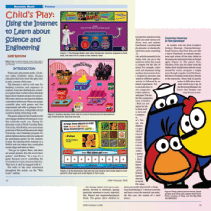 LATEST ISSUE |
||||
TMS QUICK LINKS: |
• TECHNICAL QUESTIONS • NEWS ROOM • ABOUT TMS • SITE MAP • CONTACT US |
JOM QUICK LINKS: |
• COVER GALLERY • CLASSIFIED ADS • SUBJECT INDEXES • AUTHORS KIT • ADVERTISE |
|
| Materials World: Feature | Vol. 57, No.10, pp. 12-15 |
Child's Play: Using the Internet to Learn
about Science and Engineering
KELLY RONCONE
| ||
| ||
| ||
| ||
| ||
| ||
| ||
| ||
|
Questions? Contact jom@tms.org. © 2005 The Minerals, Metals & Materials Society |
INTRODUCTION Nanoscale amusement parks. Exclusive clubs. Celebrity tutors. Science education that feels more like play time is only a mouse click away. The Internet is rich in web sites for budding scientists and engineers to explore, from sites that help pre-schoolers explore their worlds to those that help high school students prepare for careers. Most sites, however, are aimed at children somewhere in between. Many encourage scientific play with games and fun experiments and offer a glimpse of science as a profession, with profiles of real scientists doing interesting work.
The games and activities found on web sites engage children in learning in a way that textbooks rarely can. During his doctorate work at North Carolina State University, Alec Bodzin, now an associate professor of Science Education at Lehigh University, ran a program for gifted children during which he gathered enrichment games for the students to play. He introduced the students to a NASA web site where they could pilot rocket ships and land on Mars.
“You get to explore Mars, and there are actual pictures that the rovers have gotten,” said Bodzin. “In a way, it’s a game because you’re controlling the rover and you’ve got a mission objective. They love it, they’re engaged with it.” While finding scientific web sites for kids is a breeze, finding sites specifically devoted to materials is not quite so easy. “Most materials professionals don’t realize that materials are an excellent way of getting kids interested in science because kids use materials all the time,” said Thomas G. Stoebe, a professor at the University of Washington. “Science has to do with understanding how things work, and they intrinsically know a lot about the properties of materials, just because they play with them all the time.” That is why Stoebe is working on a site that serves as an introduction to materials science and engineering for high school students. The site’s primary feature is a series of materials case studies performed by students at the University of Washington. Some of the more kid-friendly topics include a description of how an engine and a bicycle are made and the role of materials selection in these items. A well-illustrated section on biomaterials provides detailed definitions of difficult terms and plenty of opportunities for clicking. The site also includes definitions of basic materials terms, like ceramics and memory metals. Stoebe is also working to develop the on-line National Resource Center for Materials Education, a project funded by the U.S. National Science Foundation (NSF). When finished, this web site will serve as a clearinghouse of teaching tools for materials technology.
Virtual Materials Exhibits The Strange Matter web site is completely devoted to materials, paying particular attention to exotic materials like Nitinol and magnetorheological fluids. The games allow children to understand the properties and processing of materials. Kids can send various raw materials (silicon, iron, and carbon) through the Transformer, a machine that will heat, apply pressure, or chemically treat the raw material to create something new (Figure 1). For an activity with the potential to be a bit more rowdy, kids can go to the Materials Smackdown, where they watch various items compete for the title of strongest material. For example, video footage of wood and aluminum being crushed in a machine demonstrates how the materials respond to pressure and how each is suited to different applications. Each activity is followed by an idea for a related experiment. For example, kids can learn how to make their own composites out of ice and other additives like sawdust and paper. The fun part comes after the composites have been frozen in hockeypuck shapes. Kids can test which is strongest by hitting them off a brick wall with a hockey stick and seeing which composite breaks first. At London’s Science Museum, the Challenge of Materials Gallery is a permanent exhibit devoted to the use of materials throughout history. Visitors to the exhibit’s web site can browse through items from the exhibit’s collection and play games that test (and strengthen) their knowledge of materials. At the Materials Sound Machine, players are given clues that help them identify a material (“Today’s worldwide industry in this metal started in 1856 when Henry Bessemer discovered a cheap way of producing it.”) Answer correctly and hear a noise the material can make. (In this case, the sounds of a steel drum.)
Exploring Materials at the Nanoscale At the Nanozone, an expansive nanotechnology site sponsored by the University of California at Berkeley’s Lawrence Hall of Science, the NSF, and the Center of Integrated Nanomechanical Systems, kids can get an idea of just how small a nanometer is through a series of games and activities (Figure 3). Here, kids can print a nanoruler that allows them to measure ordinary items in nanometers and use the scanning electron microscope, which lets them see paper, daisies, and wasps close up. The site also features interviews with and cartoon-like stories about scientists who work with nanotechnology to do things like fight disease and make solar cells. The scientists provide answers to questions children might ask about nanotechnology and give insight into why they chose their profession. JUST FOR GIRLS While there may be a shortage of women in science and engineering, there is not a shortage of on-line resources for girls interested in the sciences. Several sites cater specifically to young girls, offering career development advice, friendship, and science activities. (For an interview with an unlikely female role model for young girls interested in math and science, see the “Celebrity Math Tutor” sidebar.)
Engineer Girl The girls decided that the name had to go. So did the look. The site was meant to be for them, so it needed more color, more graphics, and more fun, according to Mary Mattis, senior program officer for the NAE Diversity Program. So, the Celebration of Women in Engineering became Engineer Girl, a hipper, younger site that better matched its intended audience. The redesigned site has information on how to become an engineer, a gallery of female engineer profiles , games, and links to other helpful sites. “We have a feature where girls can contact women in the gallery,” said Mattis. “I was talking to one of the women featured in the gallery and she says she hears from a couple of girls each semester. She loves hearing from them and always responds to their questions.” The site is popular; the number of monthly hits has been steadily growing. But it is hard to tell the kind of impact that it is having on girls’ career decisions, according to Mattis. What the NAE can see is that a number of visitors are interested enough to contact the women engineers, to experiment with the games, and participate in the contests. Join the Club America’s first woman in space, Sally Ride, lends her well-known name to the Sally Ride Science Club, an on-line meeting place for girls who like science. The site features profiles of women scientists, news for kids, and experiments for kids to try. For those who join the club, newsletters, message boards, and discounts on Sally Ride Science Festivals and Science Camps are available.
The Canadian Association for Girls in Science (CAGIS) offers a similar opportunity for sisterhood. Not only does it have the feel of an exclusive-no-boys-allowed club, it has the look as well: the home page is a club house set high in the branches of a tree. Canadian girls aged 7–16 can sign up for membership, which includes a one-year subscription to Yes Mag: Canada’s Science Magazine for Kids, a quarterly newsletter, and access to the site’s on-line resources and chapter meetings. SCIENCE FOR PRESCHOOLERS? Teaching a preschooler to appreciate nanoscale materials or the properties of metals is a task few educators would undertake, but a chick, a robin, and a duck do their best to prepare their preschool viewers for future success in science (Figure 4). These three characters host the Peep and the Big Wide World web site, which is based on the animated television show produced by WGBH Boston. The show follows the adventures of Peep (a recently hatched chick) and his two friends, Quack and Chirp, as they explore their surroundings, which they call the Big Wide World (Figure 5). “We avoid the challenge [of teaching science concepts to preschoolers] by really trying not to teach,” said Marisa Wolsky, producer of Peep and the Big Wide World. “Our purpose is actually more to promote inquiry skills and science process than science concepts, because it’s really more developmentally appropriate.” Rather than trying to teach preschoolers, for example, how photosynthesis works, the show and the web site encourage kids to learn about more basic things, like how objects cast shadows. To facilitate this, the show developed a web site where small children can play games that reinforce ideas presented in the show, like mixing colors to create new colors. The games are designed to be navigated by a non-reader. Directions are spoken, not written, and they can all be played with a few simple mouse clicks. The site also includes a section for parents on anywhere science activities, simple activities that require few or no materials but that introduce kids to the idea of experimenting with the world around them.
“We really want the show to serve as a catalyst for science play,” said Wolsky, who hopes that when kids turn off the television show, they will be encouraged to go out and explore their own worlds. Kelly Roncone is news editor for JOM.
|








